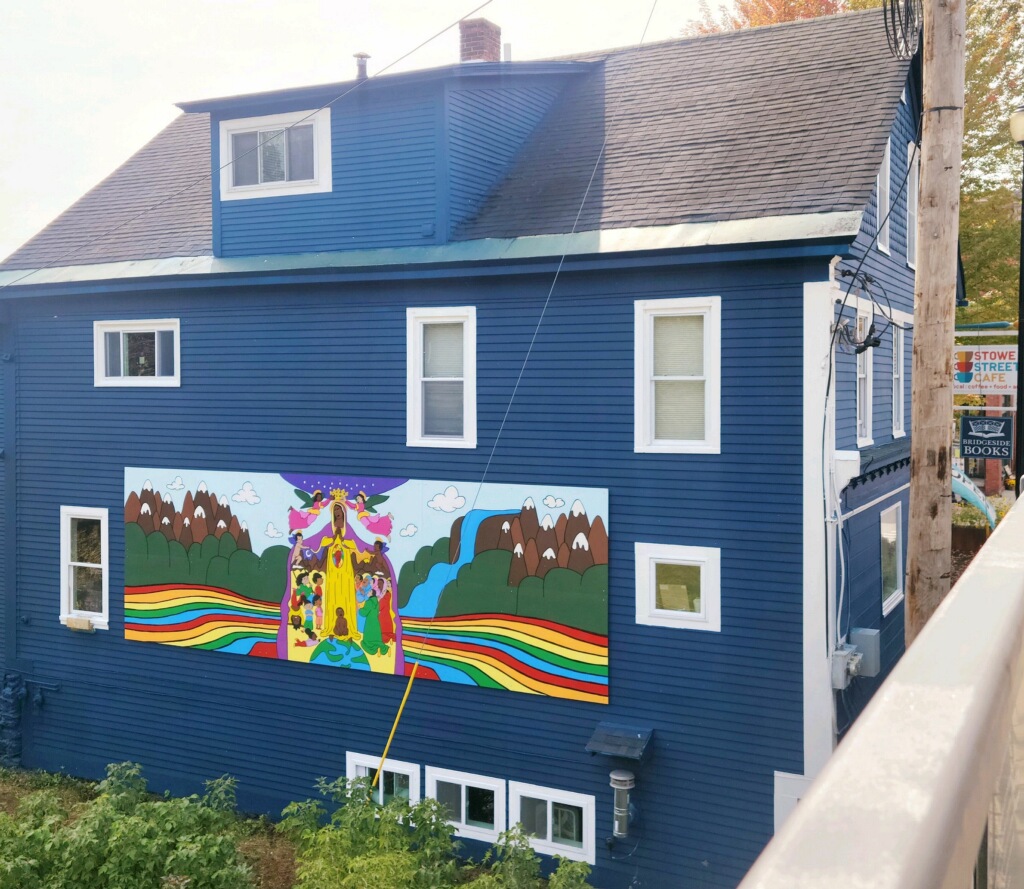Information about the Madonna's Earth mural
The Waterbury Area Anti-Racism Coalition (WAARC) mission is to create a community where every person can fully experience freedom, belonging, and love on a daily basis. To pursue this vision, WAARC is committed to challenging racism at all levels, including interpersonal racism (both conscious and unconscious acts) and systemic racism (our local institutions and policies), while actively creating spaces and events that promote learning, inclusion, and freedom dreaming.
WAARC chose Raphaella Brice as the artist for this project through an extensive selection process involving several strong proposals. The Selection Committee was impressed by Raphaella’s artistic vision, interpreted through their unique experiences while simultaneously speaking to universal truths. The hope is that the mural will beautify our town, compel community conversations, and amplify Waterbury as a local and tourist destination for arts and culture, expanding the creative economy.
Artist introduction in their own words
My name is Raphaella “Raph” Brice and I am a self-taught digital artist & emerging multi-media muralist. My go-to physical mediums are paint, vinyl, and creating laser-etched objects. I describe my style as “cultural-psychedelic” — where culture meets the surrealism of my inner and outer expression of the world as a black femme body. I mainly draw knowledge from my Haitian-Catholic background and use spiritual & mystical concepts to celebrate the human consciousness shift happening in the world today. In a time where COVID revealed the false illusions of our current systems in place, the art I create portrays the layers of human existence while using exuberant color palettes to create timeless visual stories.

Artist statement about the mural design
“Madonna’s Earth” is a depiction of influence from the purest divine feminine in human history – the Black Madonna. The Black Madonna is a mystagogue, known all over the world as a great mystery, a powerful archetype of transformation, and mother of Jesus Christ. The Black Madonna is both a living reality and an archetypal embodiment of human behavior – she is both paradox and ambiguity. Through her loving acceptance of all of us, and valuing the interrelatedness of all life, the Black Madonna brings us to wholeness & stillness. Following the COVID-19 pandemic, her presence reminds us of the sacredness of life, the need for care, nourishing the earth, and ourselves, as evolving sentient beings. Growing up Haitian-Catholic has been a huge influence in how I see & interact with all walks of life, which inspired this piece.
The piece illustrates her pure love through providing shelter to peoples of all walks of life, who are peacefully standing or playing under her dress – inspired by a Haitian Vodou story from the book, “Nan Dómi” by Mimerose Beaubrun.
Additional Resources
About the book Nan Dómi by Mimerose Beaubrun
See the Google Books preview here. This book is an account of Mimerose P. Beaubrun’s journey and experience as a Vodou initiate. For further information about the inspiration behind the “Madonna’s Earth” mural, see Chapter 17 “Watch Your Step or Constant Attention” in Nan Dómi (pages 245 - 247).
Review of Nan Dómi: An Initiate’s Journey into Sacred Vodou, by Kantara Souffrant. This is a detailed review and description of Nan Dómi and its importance as a text for learning about Vodou, religious and spiritual philosophy, and women’s studies.
“The practice of Haitian Vodou involves penetrating the barriers between visible and invisible worlds, opening passages, gateways and crossroads.”
– Madison Smartt Bell, Preface to Nan Dómi by Mimerose Beaubrun
About the connection between Haiti and the the Black Madonna of Częstochowa, Poland
Haiti and the Polish Madonna, by Bogdan Kotnis on Kuryer Polski. This article explores the origins of how the Polish Black Madonna evolved into Erzulie Dantor, the lwa (Vodou spirit) of Haiti.
Black Madonna of Czestochowa becomes lesbian defender Erzuli Dantor, by Kittredge Cherry on Qspirit.net. This article also explores how the Polish Black Madonna transformed into Erzulie Dantor, the lwa who is recognized as a patron of lesbians who fiercely loves and defends women and children, independent business women, unwed mothers, and those who experience domestic violence. It also explores the ongoing controversy that arose when a rainbow halo was added to the Black Madonna of Czestochowa.
About the Black Madonna
The Black Madonna: A Theoretical Framework for the African Origins of Other World Religious Beliefs, by Janet Michello in the journal Religions. This academic review “summarizes existing scholarship in order to theorize how Abrahamic religions and Hinduism were influenced by African beliefs, in order to illuminate the contributions that African beliefs have had on other world religions.”
Race, Religion, and the Black Madonna, by Daniela Vasco. This article explores histories of the Black Madonna that have been neglected in favor of Western, male-centric narratives and their importance in talking about issues of institutional racism, sexism, and inequality.
Black Madonnas: Origin, History, Controversy, by Michael Duricy on the University of Dayton website. This article explores the histories of the Black Madonna and theories as to their origins.

